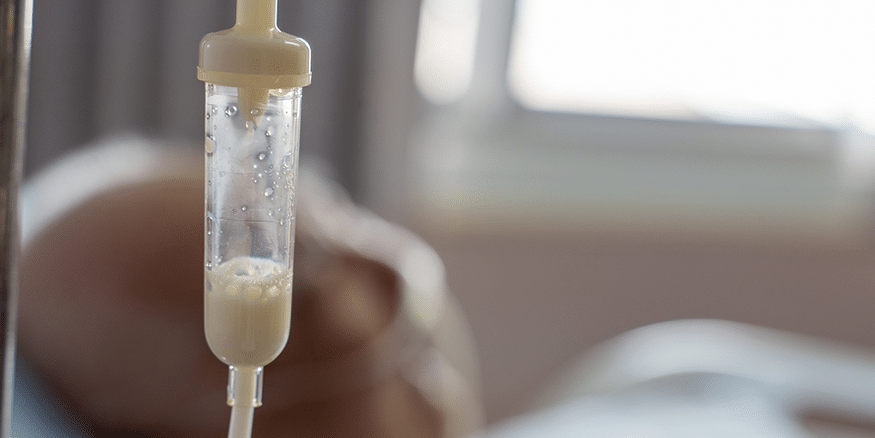
Parenteral Nutrition
What is Parenteral Nutrition?
Parenteral nutrition (PN) is the delivery of nutrients through intravenous access, when the gastrointestinal tract is not working. The nutrients given include protein, carbohydrate, fat, vitamins and minerals, electrolytes, and water. Total volume is also an important factor because some patients require a fluid restriction.
When is parenteral nutrition given?
The main reason for using parenteral nutrition is when a person has a nonfunctioning gastrointestinal tract. Indications for PN include severe malabsorption (e.g. severe Crohn’s disease), short bowel syndrome (related to disease or surgical removal of a large portion of the gut), intractable vomiting or diarrhea, ileus, radiation enteritis, or fistulae. Patients needing bowel rest (e.g. severe pancreatitis), or those with severe malnutrition who cannot be adequately fed through oral or tube feeding method may also require PN. Parenteral nutrition is usually contraindicated in patients with a functioning gut or when venous access cannot be obtained.
How is it started?
Once the nutrition support team, deems an individual suitable for parenteral nutrition, they obtain enteral access. There are four main types of central venous access devices (CVAD) for PN: Nontunneled catheters, tunneled catheters, peripherally inserted central catheters (PICC), and implanted ports. Nontunneled catheters are for short-term use and can be inserted quickly through a central or peripheral site. Tunneled catheters (i.e. Hickman, Groshong) are for long-term use, and are tunneled subcutaneously away from the site of insertion. Tunneled catheters have a lower risk of infection because they have a cuff that prevents microorganism migration into the catheter tract. Another long-term CVAD is the PICC line, which is inserted through a vein in the arm with the tip ending in the superior vena cava. PICC lines have a low risk of infection but need to have a slow infusion of fluids because they can occlude and migrate more easily than other CVADs. Implantable devices are surgically inserted completely under the skin, requiring a special needle for access. These have a low risk of infection, but can be painful with continued skin punctures, and are less commonly used because they need to be inserted and removed surgically. Most access devices contain at least two lumens so that more than one line can be used at once.
The team (Physician, Dietitian, Pharmacist, and Nurse) then determines a person’s caloric, macronutrient, micronutrient, and fluid requirements. Depending on whether a person is stressed or unstressed, he/she will generally require about 15-20% of calories from protein. There are special amino acid formulae available for people requiring protein restrictions (e.g. kidney or liver disease), and formulae containing glutamine are also available. Carbohydrates are given in the form of dextrose, and fat in the form of lipid emulsions of safflower oil or soybean oil. Parenteral nutrition is contraindicated in people with egg allergies because the lipid emulsion contains egg yolk as an emulsifier. Micronutrients given include sodium, potassium, chloride, multivitamin, magnesium, phosphate, calcium, and trace elements (copper, chromium, molybdenum, iodine, selenium, and zinc). Vitamin K is found in lipid emulsions but is usually given additionally, except in patients receiving anticoagulation therapy (i.e. Coumadin®). Intravenous iron is rarely given because of the possible anaphylactic reaction and its instability in solution. Certain drugs (e.g. insulin, hydrocortisone) may be given with the PN at the physician’s discretion.
What are the different formulations of PN?
Parenteral nutrition can be provided either through two lines: 2 in 1 or protein/carbohydrate/micronutrients and lipid emulsion; or through a single line: 3 in 1 or Total Nutrient Admixtures (TNA). Since the intravenous access often has two or more lumens, either formulation can be used. Fat emulsions are unstable when mixed with the protein/carbohydrate/micronutrient solution, so when using the 3 in 1 solution, the lipids are combined shortly before administration. People on home PN often use total nutrient admixtures because there are fewer lines to handle and fewer line infections. The disadvantages of TNAs are that additives like calcium and magnesium may be limited because of the risk of precipitation and in-line filters cannot be used.
What are the risks of PN?
The complications of PN are metabolic, catheter-related, and gastrointestinal risks. Metabolic complications include electrolyte imbalances, hyperglycemia, hypertriglyceridemia, azotemia, essential fatty acid deficiency, overfeeding, and volume excess or deficit. Catheter-related complications include infection, pneumothorax, occlusion, thrombosis, or line malposition. Gastrointestinal risks are gastrointestinal atrophy (due to lack of use), fatty liver, and cholestasis. Monitoring for these potential complications is essential in minimizing the risks.

